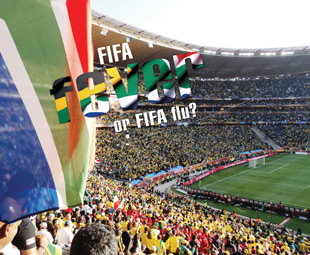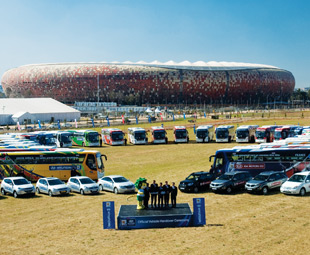FIFA fever of FIFA flu?

The World Cup is over. Tourists, teams and officials have gone back home. Now, the clean-up starts and the euphoria ceases. Plus, as CAITLYN MOONY points out, we have hundreds of additional buses and coaches on our roads.
The past month has been something really special. There has been an undeniable hum in the air (and I don’t mean from the vuvuzelas alone, although they certainly played their part). South Africans radiated an energy that could not be ignored by even the most cynical of residents.
All around OR Tambo Airport in Johannesburg flags flew high. Everyone felt a warm glow that could only be chalked up to “national pride”. Although there were originally doubts as to whether South Africa would be capable of successfully holding such a large-scale event, optimism got the better of us. Jo’burgers could be seen driving around with their windows rolled down, peering over their flag-covered side mirrors and taking in the colours and sounds that have flooded the city in the last few months.
However, in our new found enthusiasm and acceptance of the fact that we could indeed successfully host the World Cup, we seem to have forgotten to ask the all important question: “What now?” Now that the tourists have stampeded in and out of the country, leaving their euros in our pockets, we are left with the aftermath to clean up. What will happen to the thousands of flags adorning peoples’ cars and homes? Will we need to create giant vuvuzela dumping grounds? Will the streets be lined with empty, abandoned buses with the 32 teams’ national colours fading woefully in the afternoon sunlight?
Although the problem of the vuvuzelas and flags might be a little sad, the problem of the hundreds of buses and coaches that have been brought into the country specifically for the World Cup is a slightly more serious one. Luxury coaches and passenger buses were brought into South Africa in order to transport the national teams, VIPs, tournament organisers, FIFA officials, referees, the media and, of course, the tourists.
Hyundai was the official automotive supplier of the 2010 FIFA World Cup, and supplied 64 Universe Express luxury coaches to the participating teams. These could be easily spotted throughout the country as they were brightly decorated in the teams’ national colours as well as flags and a slogan specific to each country. This, incidentally, was very useful for determining exactly which team had just blocked you off at the intersection of Fredman and West.
Hyundai is not the only company that supplied buses however. MAN Truck & Bus sold 110 79-seater MAN HB4 Lion’s Explorer intercity buses to Autopax for use during the World Cup. The buses were used to transport soccer fans to matches when the main spectator fleet was at capacity.
Marcopolo reported that it experienced a whopping 282% growth in bus body production in South Africa because of the World Cup. As official sponsors to the Bafana Bafana team, Mercedes-Benz South Africa (MBSA) supplied the team with a Mercedes-Benz Multego luxury coach, built by Marcopolo. This comfortable 40-seater was given to the team to tour the country in the build-up prior to kick-off.
MBSA also sold 460 luxury coaches to Autopax and the Passenger Rail Agency of South Africa; 168 intercity coaches and 292 semi-luxury coaches. Collectively these are worth a reported R1.2 billion. These coaches were delivered to Autopax by debis Fleet Management (dFM), the fleet management arm of the Mercedes-Benz group of companies.
According to Marius Botha, head of Volvo Buses in South Africa, the company also supplied buses for the purposes of the World Cup. A total of 25 buses went to Nelson Mandela Bay’s Integrated Rapid Transport (IRT) service and 43 went to the city of Cape Town’s IRT. The buses in the Nelson Mandela Bay IRT system are all B9SLA models, capable of carrying 115 passengers. Eight of the 43 buses in Cape Town’s IRT system are Volvo articulated B12M models with a seating capacity of 160, and the other 35 are 12-metre Volvo B7R buses with a seating capacity of 53.
Gideon de Swardt, Scania South Africa’s area manager for promotions and communications, reported that 143 Scania buses were sold to Johannesburg’s IRT system (the IRT system is inclusive of the Bus Rapid Transport (BRT) System). Some 41 of these are articulated 112-seater buses, whereas the other 102 are conventional 81-seater units.
With this increased need for transportation came the increased need for drivers. MAN Truck & Bus trained 220 drivers on behalf of Autopax to meet the demand, while Springbok Atlas recruited 60 new drivers for their fleet. Autopax assessed 230 recruits for the new fleet of buses, drawing most of these recruits from its existing pool of drivers. Drivers were also sourced from pre-existing companies who had had to retrench due to downsizing. MAN deemed 220 of these drivers suitably skilled for training for the new technologically-advanced fleet, meaning two drivers per bus were employed. They recruited the drivers in this way to ensure their drivers would have experience as well as a clean track record. Both companies selected their drivers carefully, through driving capability tests and medical examinations.
Bus companies did not skimp on training for their new drivers either. MAN drivers were trained in bus product information, safety operation, specialist operation driver training and defensive driver training. Safety was the most important factor for MAN, both in the design of the new buses and in the rigorous driver training. Springbok Atlas focused on developing their crew’s skills as part of an intensive three-month course, where they were given proactive driving training, co nvoy, task-force, fire technology and public relations training.
nvoy, task-force, fire technology and public relations training.
For its part, MBSA’s dFM implemented its SETA-approved “train-the-trainer” concept for 20 drivers. This involves carefully choosing and training a selection of drivers from within existing fleets – in an intensive eight month course – so that they are then able to train other existing and new drivers in the use of the specialist vehicles. Thereafter Autopax continued the training for the individual drivers. “This leads to a professional career path for senior drivers or trainers,” says Aluwani Ramabulana, chief executive officer of dFM.
THE AFTERMATH
But, before we shout “Hoorah! New jobs have been created! We’ll have better public transport!”, let’s not forget that on July 11 the final match was played, and the hordes of tourists began their exodus home. The teams are no longer here to utilise those beautifully tailor-made buses; neither are the overseas tourists. So who will?
While the Volvo and Scania vehicles are by and large going to stay in the Metro regions’ IRT systems, as this is a long-term plan for South Africa’s public transport, the assorted luxury coaches that were in use will need to be sold onto the open market. As for the other companies now in possession of expanded fleets, according to Stanley Anderson, the marketing and after-sales director at Hyundai South Africa, FIFA initially expressed interest in purchasing some of the official team buses to give to underprivileged schools for example, but the deal was not finalised and all the buses will now be sold into the open bus market. It will be interesting to see how successful those sales will be.
Ettienne du Preez, general manager of Hyundai South Africa Commercial Vehicle Division, remains positive, saying that they have been fortunate enough to have had a lot of interest in the vehicles FIFA used. Du Preez points out that the impact will mostly be on the sale of new rather than second-hand vehicles, because of the sudden availability of hundreds of barely-used luxury coaches after the World Cup. Springbok Atlas found the same thing.
MBSA envisages that its coaches will provide much needed day-to-day intercity transport long after the World Cup is over, and MAN and Autopax are also confident that the buses will continue regular Autopax intercity routes.
However, according to Andrew Kirby, senior vice-president of sales and marketing at Toyota South Africa, in the month of May this year there was a massive spike of 127.7% in bus sales when compared to the same month last year. This level of activity is certainly not sustainable… especially with a bunch of nearly new units on the market.
Another problem is the drivers who were specially recruited and trained to drive buses. Now that the World Cup is over, they could be left jobless. Although Springbok Atlas plans to employ some of the drivers at its national branches, many will not have such an opportunity. But Jan Aichinger, divisional manager of Mercedes-Benz’s Bus and Coach Division, optimistically points out that, “there is an extreme shortage of skilled, qualified drivers in the transport industry, these drivers can easily be absorbed into the trucking industry.” Presumably the skills learned by these drivers will be transferable making them employable across different sectors of the transport industry.
Lest we slip back into a pessimistic frame of mind, let us not forget that negative comments about our ability to get even this far abounded when many South Africans first heard that the World Cup was going to be held here. “Look at the state of our airports!” some people exclaimed. “We’ll never have the highways ready in time!” they cautioned, while some said that this country would never be able to offer enough accommodation.
Now that the event is done ‘n dusted, we all have memories of diski dancing, vuvuzelas, makarakas, and the contagious enthusiasm of local and international fans alike. We have larger and more efficient international airports, and improved highways. All in all, it wasn’t bad – those doomsayers were wrong.
Hopefully, in a few months time we’ll be celebrating the success of a resilient bus and coach market, as much as our ability to clean up after the party.
Published by
Focus on Transport
focusmagsa




